Qantas unveils cabins for Project Sunrise ultra-long-haul flights
Qantas has unveiled the final details of its long-anticipated Airbus A350 ultra-long-haul cabins that will be used on its Project Sunrise routes non-stop to Paris, New York and London from Sydney and Melbourne in late 2025.
Speaking at a press conference in New York one day after the inaugural QF3’s non-stop flight from Auckland, Qantas chief executive Alan Joyce revealed details for the A350’s economy and premium-economy class cabins, as well as a specially designed area for passengers’ wellness.
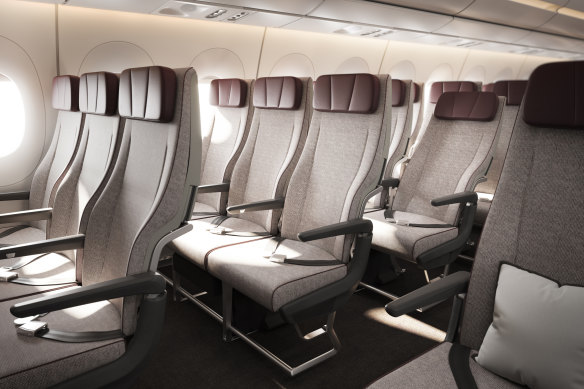
The economy-class seats on board Qantas’ Airbus A350 will be larger than on any other Qantas aircraft.
Though none of the rumoured bunk-beds or gyms materialised, the 12 specially designed Airbus A350s will introduce a “Wellbeing Zone” between the premium-economy and economy cabins which gives passengers space to stretch, with sculpted walls and integrated handles to facilitate balance.
Guided content will be televised from an entertainment screen to encourage movement, but the area has also been designed for socialising with fellow passengers, with a self-serve snack bar.
While the designs for its first and business-class cabins were revealed in February, details of its much-anticipated premium-economy and economy seats – where 180 of the aircraft’s 238 passengers will be seated for the flights lasting up to 22 hours – were kept under wraps.
With 33 inches of legroom (84 centimetres), the 140 seats in economy will have the largest pitch of any Qantas economy cabin, which is one more inch than the seats in its Boeing 787 Dreamliners.
In a 3-3-3 configuration, the seats will include a six-way adjustable headrest, footnet and an extra shelf for portable devices.
The 34-centimetre seatback screens will contain Bluetooth connectivity allowing passengers to bring their own headsets and still be able to tune in to Qantas’ inflight entertainment. Each seat will also contain two fast-charging USB outlets.
Configured to a 2-4-2 layout, the premium-economy cabin has been redesigned and the 40 seats will have a 40-inch (102-centimetre) pitch – two inches larger than on the 787s and the largest seats of all their premium-economy cabins. The seat also features a winged headrest which supports the neck while delivering a modicum of privacy.
Australian designer David Caon said the new headrest wings “are the biggest visible difference and will provide passengers with both additional support and a sense of privacy. An upholstered ergonomic foot and leg-rest system allows the body to be cradled in recline to better help passengers sleep”.
The airline hopes fewer seats and extra legroom will encourage movement, especially for those in the middle seats, as the extra centimetres of space will help them to move past the person in the neighbouring aisle seat.
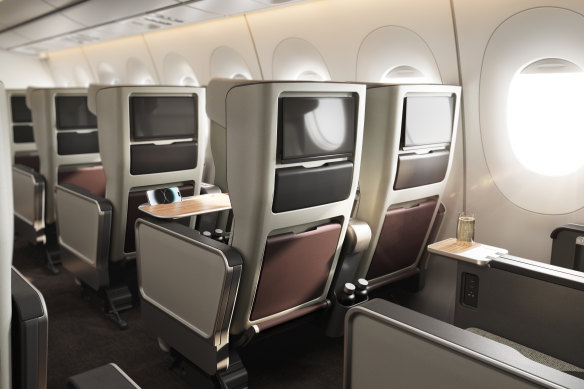
The premium-economy seat design.
At the pointy end of the plane, Joyce joked that the six first-class pods – one of which was on display in New York on Thursday – were equipped with “everything except the dunny”. Along with a sliding privacy door, passengers will enjoy an extra-wide bed, recliner lounge chair, wardrobe, a folding, two-seater dining table and an 81-centimetre ultra-high-definition TV.
Each of the cabins has an updated look and feel, replacing the dark upholstery of the 787s with lighter grey and neutral tones, thought to elevate moods.
The new aircraft will also feature free Wi-Fi for all passengers, a frustration for a lot of business-class passengers unable to work during long-haul flights.
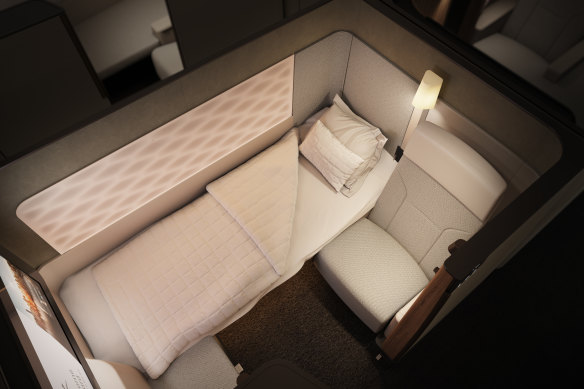
First class on board will feature ‘everything but the dunny’.
“When you get outside Australia, the satellite coverage is not great which means you have to charge passengers for a very slow and bad service compared to what we see in domestic flights,” Joyce said. “So we are waiting for the satellites to be launched over the Pacific which will allow us to offer high-speed Wi-Fi, for free, to everybody.”
Joyce has previously indicated the airline expects to charge a premium of about 20 per cent on its airfares to New York and London for those wanting to fly on the non-stop routes.
At the heart of the cabin design is scientific research conducted with the University of Sydney’s Charles Perkins Centre, which saw assessments carried out on passengers on test flights for Project Sunrise in 2019.
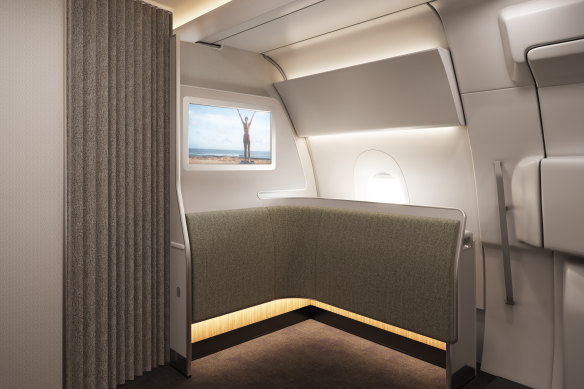
The planned ‘Wellness Zone’ on board.
Parallel testing had also been conducted on cabin crew from other ultra-long-haul flights operated by Qantas. The airline has received criticism from the Flight Attendants Association of Australia for using New Zealand crew on its non-stop flight from Auckland to New York, after New Zealand staff voted to reduce the rest time the airline is required to provide staff.
While they admit they are yet to carry out the tests on a wider group of travellers, the results found that jet lag could be reduced – but not eliminated – through cabin lighting, food consumption, movement and mood.
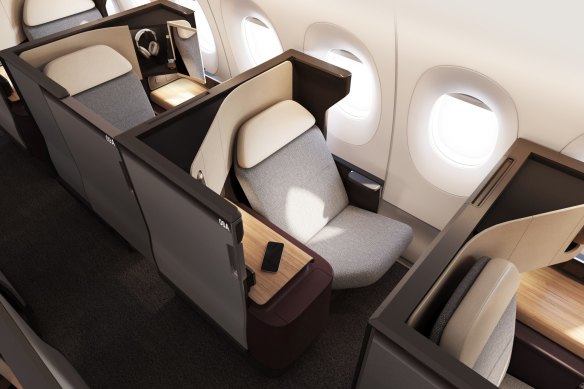
The new business-class seats for the Project Sunrise flights.
Speaking at the press conference, Professor Svetlana Postnova, neurophysics and brain dynamics specialist at the University of Sydney, said, “first, we found that the duration of self-reported jet lag is shortened by about two days in the optimised groups compared to the traditional ones.”
“Second, we found that alertness in the days immediately following the flight is higher in the optimised group than the traditional one.”
Further testing is set to be conducted at Airbus’ Hamburg headquarters later this year, when specialists will design the lighting settings for each part of the Project Sunrise flights.
The writer travelled as a guest of Qantas.
Sign up for the Traveller newsletter
The latest travel news, tips and inspiration delivered to your inbox. Sign up now.